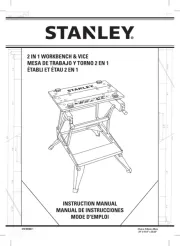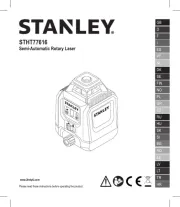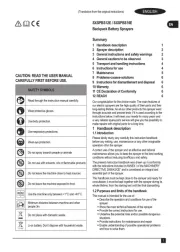Stanley S100 Handleiding
Bekijk gratis de handleiding van Stanley S100 (50 pagina’s), behorend tot de categorie Niet gecategoriseerd. Deze gids werd als nuttig beoordeeld door 277 mensen en kreeg gemiddeld 4.6 sterren uit 139 reviews. Heb je een vraag over Stanley S100 of wil je andere gebruikers van dit product iets vragen? Stel een vraag
Pagina 1/50

9
REV A 08STHT77403
S100
2
11
>
3
3
3
33
sec
sec
sec
sec
sec
9
2 3 6 7
11
>
≤
3
3
3
33
sec
sec
sec
sec
sec
4 5
3
3
3
33
sec
sec
sec
sec
sec
1 77403
1
Stanley Stud Sensor 100
The Stud Sensor 100 uses electronic signals to locate the edges of
studs, joists or live AC wires through drywall or other common building
materials. Once the edge of a stud has been detected, the Stud Sensor
100 displays red LED’s and sounds an audible tone. A marking channel
allows you to easily note the stud edges on the wall.
Note: Read all instructions prior to operating the Stud Sensor 100 and
DO NOT remove any labels from the tool.
WARNING:
Protect Your Eyes, Wear Safety Goggles.
Usage
Detecting Wood / Metal Studs
2 Hold the Stud Sensor 100 fl at
against the surface, making fi rm
contact.
3 Press in and hold the activation
button. The green and top red LED
will light.
Note: The unit cannot be moved
before calibration is complete.
6 When it detects the stud edge,
the top LED will go on and an
audible tone will sound. Use the
marking channel located at the top
of the unit to mark the stud edge.
7 Repeat the above steps from
the other side of the stud. Coming
from the opposite direction, mark
the other edge of the stud.
OPERATING INSTRUCTIONS
Battery
1 Open door on back of unit and connect a 9 volt
battery (not included) to clip. Put battery back into
case and close back battery door.
Note: Recommend to replace a new 9 volt
battery when low battery - fl ashing green LED.
11 If the red LED stays lit, move the Stud
Sensor 100 to a different location and try again.
Releasing the activation button will turn off the
sensor.
Note: While calibrating, the Stud Sensor 100
must not be placed directly over a stud, dense
material such as metal, or over a wet or newly
painted area, or it will not properly calibrate.
9 Slide the Stud Sensor 100 slowly across the surface in a straight
line. As it detects a stud, the red LED’s will go on.
• Marking Channel
• Live Wire Warning LED
• LED Display
• Activation Button
• Self-Calibration Complete /
Low Battery Indicator
4 When the red LED goes off, the
unit is calibrated.
5 Keep holding the activation
button during all of the following
procedures.
Note: Once the Activation button
is released, the unit shuts off.
• Live Wire Detected
• STUD Detected

©2012 STANLEY TOOLS
www.STANLEYTOOLS.com
701 East Joppa Road
Towson, Maryland 21286
8
2 77403
10
OPERATING TIPS
The Stud Sensor 100 is designed for use only on interior surfaces.
Prevent Interference
To ensure best performance from the Stud Sensor 100, keep your
free hand at least 6 inches away from the unit and wall surface
while testing or scanning surfaces.
Conventional Construction
Doors and windows are commonly constructed with additional studs
and headers for added stability. The Stud Sensor 100 detects the
edge of these double studs and solid headers as a single, wide stud.
Surface Differences
The Stud Sensor 100 will scan through common building materials,
Including:
• Gypsum drywall
• Plywood sheathing
• Hardwood fl oors
• Linoleum over wood
• Wallpaper
The sensor cannot scan through:
• Carpeting
• Foil faced materials
• Ceramic tile
• Cement or concrete
• Metal & plaster walls
Wallpaper
There will be no difference in the function of the Stud Sensor 100
on surfaces covered with wallpaper or fabric unless the coverings
used contain metallic foil or fi bers.
Ceilings
When dealing with a rough surface such as a sprayed ceiling,
utilize a piece of cardboard when scanning the surface. Run
through the calibration technique described earlier with the piece
of cardboard too, to assure best performance of the unit. Also, it is
particularly important in this application to remember to keep your
free hand away from the unit.
Note: The thickness, density and moisture content of the surface
material will affect the sensing depth.
IMPORTANT SAFETY NOTICE
Insure proper detection of live wires. Always hold the Stud Sensor
100 in the handle area only. Grasp between fi ngers and thumb while
making contact with your palm.
SPECIFICATIONS
(At 35-55% relative humidity)
Battery 9 volt (not included)
Depth Range
Wood or Metal Studs Up to 3/4” (19 mm)
through drywall
Live AC Wires
(120 volts AC)
Up to 2” (50 mm)
through drywall
Accuracy - Stud Center
(Scanning and marking the stud from two sides stud center)
Wood ±1/8” (3 mm)
Metal ±1/4” (6 mm)
Operating
Temperature +32°F to +120°F (-0°C to +49°C)
Surface
Temperature -4°F to +150°F (-20°C to +66°C)
WARRANTY
Stanley Tools warrants the Stud Sensor 100 against defects in
material and workmanship for one year from the date of purchase.
Stanley’s liability under this warranty is limited the replacement
of the unit. Any attempt to repair the product by other than factory
authorized personnel will void this warranty. Calibration, batteries
and maintenance are the responsibility of the user. Where permitted
by law, Stanley is not responsible for incidental or consequential
damages. Agents of Stanley cannot change this warranty. Stanley is
not responsible for damage resulting from wear, abuse or alteration of
this product. The user is expected to follow ALL operating instructions.
This warranty may provide you with additional rights that vary by
state, province or nation.
8 The midpoint of the two marks indicates the
stud center.
Detecting Live AC Wires
10 The live wire red LED will illuminate and the
Stud Sensor 100 sounds an audible tone, warning
when in the proximity (typically within 4” to 18”
along the surface) from a live wire.
Note: Static electrical charges that can develop on drywall and
other surfaces will spread the voltage detection area many inches
on each side of the actual electrical wire. To aid in locating the
wire position, scan holding the unit ½” away from the wall surface
or place your other hand on the surface approximately 12” from
sensor.
Warning: Shielded wires or wires in metal conduits, casings,
metallized walls or thick, dense walls will not be detected. Always
turn off AC power when working near wiring.
Cautions on Operating
You should always use caution when nailing, cutting and drilling in
walls, ceilings and fl oor that may contain wiring and pipes near the
surface. Always remember that studs or joists are normally spaced
16 inches or 24 inches apart and are 1½ inches in width. To avoid
surprises, be aware that anything closer together or of a different
width may not be a stud.

9
REV A 08STHT77403
S100
2
11
>
3
3
3
33
sec
sec
sec
sec
sec
9
2 3 6 7
11
>
≤
3
3
3
33
sec
sec
sec
sec
sec
4 5
3
3
3
33
sec
sec
sec
sec
sec
1 77403
1
Détecteur de montant 100 Stanley
Le Détecteur de Montant 100 utilise des signaux électroniques pour
trouver les bords des montants, solives ou câbles à courant alternatif
sous tension à travers les cloisons sèches ou d’autres matériaux de
construction communs. Lorsque le bord d’un montant est détecté, le
Détecteur de Montant 100 allume son voyant rouge et un son est émis.
Un canal de marquage vous permet de facilement marquer les bords
des montants sur le mur.
Remarque : Lisez toutes les instructions avant d’opérer le Détecteur
de Montant 100 et N’ENLEVEZ AUCUNE étiquette de l’outil.
AVERTISSEMENT :
Protégez vos yeux ; portez des lunettes de sécurité.
Utilisation
Détection des montants en bois/
métal
2 Tenez fermement le Détecteur de
Montant 100 à plat contre la surface.
3 Maintenez enfoncé le bouton
d'activation. Le voyant vert et le
voyant rouge supérieur s'allument.
Remarque : L'appareil ne doit pas
être déplacé avant d’en avoir ter-
miné l’étalonnage.
6 Lorsqu'il détecte le bord du
montant, le voyant supérieur
s'allume et un son est émis.
Utilisez le canal de marquage au
sommet de l'appareil pour marquer
le bord du montant sur le mur.
7 Répétez les étapes ci-dessus de
l'autre côté du montant. En venant
dans la direction opposée, marquez
l'autre bord du montant.
MODE D'EMPLOI
Pile
1 Ouvrez le couvercle à l'arrière de l'appareil
et connectez une pile de 9 volts (non fournie) à
l'attache. Placez la pile dans son compartiment et
refermez le couvercle.
Remarque : Il est conseillé de remplacer la pile
de 9 volts par une pile neuve lorsque le voyant
vert clignote pour indiquer que la pile est faible.
11 Si le voyant rouge reste allumé, déplacez le
Détecteur de Montant 100 dans un emplacement
différent et réessayez. Si vous relâchez le bouton
d'activation, le capteur s'éteint.
Remarque : Pendant l’étalonnage, le Détecteur
de Montant 100 ne doit pas être placé directement
sur un montant, sur un matériau dense comme le
métal, sur une surface mouillée ou fraîchement
peinte sous peine de fausser l'étalonnage.
9 Faites glisser le Détecteur de Montant 100 doucement sur la
surface selon une ligne droite. Lorsqu'il détecte un montant, le
voyant rouge s'allume.
• Canal de marquage
• Voyant d'avertissement de fi l sous tension
• Affi chage à voyant
• Bouton d'activation
• Auto-étalonnage terminé/
Indicateur de pile faible
4 Lorsque le voyant rouge s'éteint,
l'appareil est étalonné.
5 Maintenez enfoncé le bouton
d'activation durant l'ensemble des
procédures suivantes.
Remarque : Lorsque le bouton
d'activation est relâché, l'appareil
s'éteint.
• Fil sous tension détecté
• MONTANT détecté
Product specificaties
| Merk: | Stanley |
| Categorie: | Niet gecategoriseerd |
| Model: | S100 |
Heb je hulp nodig?
Als je hulp nodig hebt met Stanley S100 stel dan hieronder een vraag en andere gebruikers zullen je antwoorden
Handleiding Niet gecategoriseerd Stanley

29 Maart 2025

28 Maart 2025

26 Maart 2025

19 Maart 2025

22 Januari 2025

26 Augustus 2024

26 Augustus 2024

26 Augustus 2024

29 Februari 2024

29 Februari 2024
Handleiding Niet gecategoriseerd
- Oase
- Landmann
- Grillmeister
- Carrera
- Ordex
- Argus
- Tenderfoot Electronics
- AeroCool
- OP/TECH
- Hitachi
- Akrobat
- Magic Chef
- Krüger&Matz
- Royal Sovereign
- Selec
Nieuwste handleidingen voor Niet gecategoriseerd

14 September 2025

13 September 2025

13 September 2025

13 September 2025

13 September 2025

13 September 2025

13 September 2025

13 September 2025

13 September 2025

13 September 2025